Unilever: Macro Environment Impact on Business Operations Report
VerifiedAdded on 2023/01/03
|17
|5343
|61
Report
AI Summary
This report examines the influence of the macro environment on business operations, using Unilever as a case study. It begins with an introduction to the business environment and Unilever, then explores public, private, and voluntary sectors, along with different organizational types. The report delves into the relationships between organizational functions, such as finance, marketing, human resources, and information technology, and their impact on achieving business objectives. A significant portion of the report focuses on the positive and negative impacts of the macro environment, supported by specific examples, and utilizes PESTLE analysis to assess external factors. Finally, the report conducts internal and external analysis to identify strengths, weaknesses, and the interplay between these factors and the external environment, culminating in a comprehensive conclusion and references.
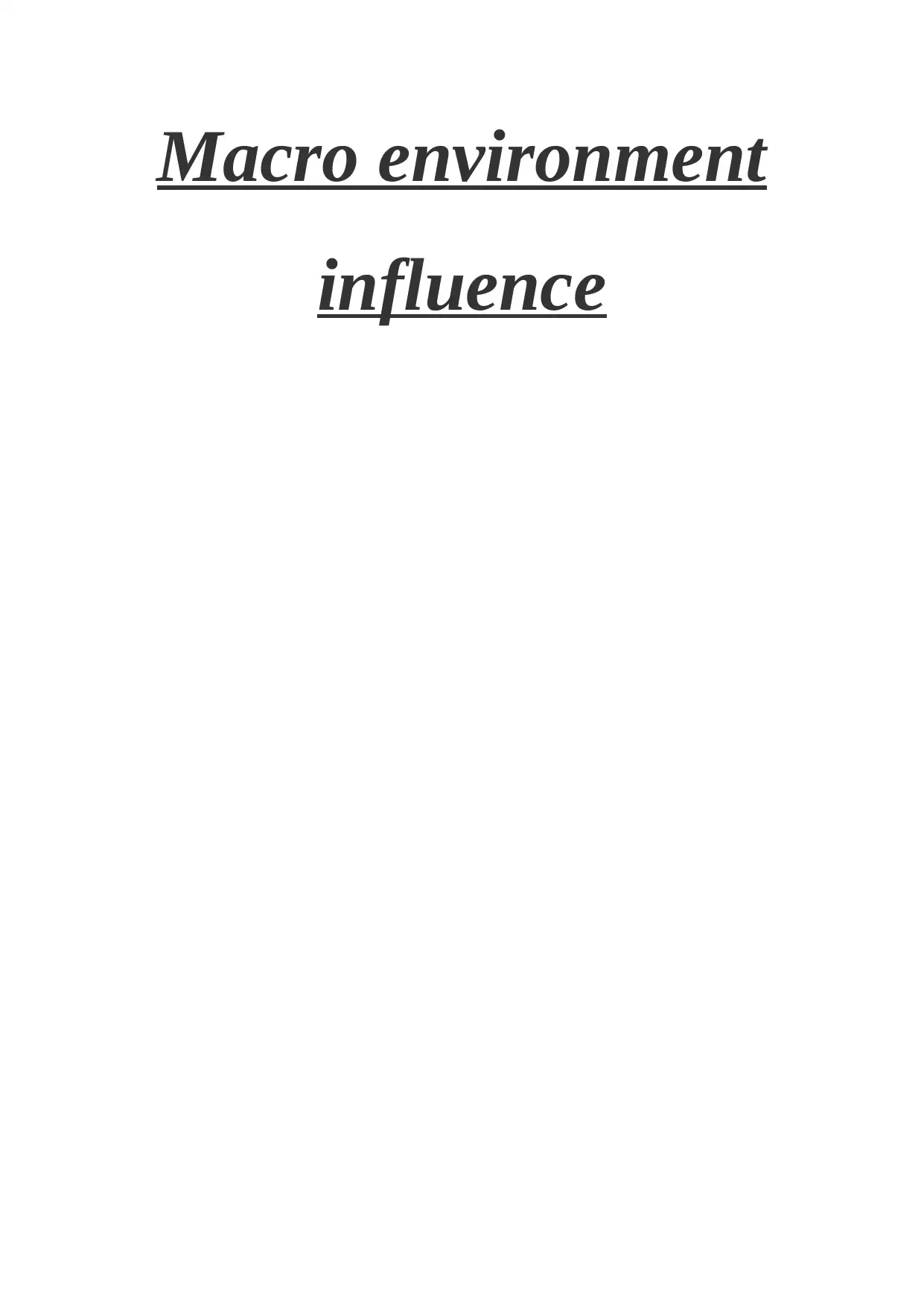
Macro environment
influence
influence
Paraphrase This Document
Need a fresh take? Get an instant paraphrase of this document with our AI Paraphraser
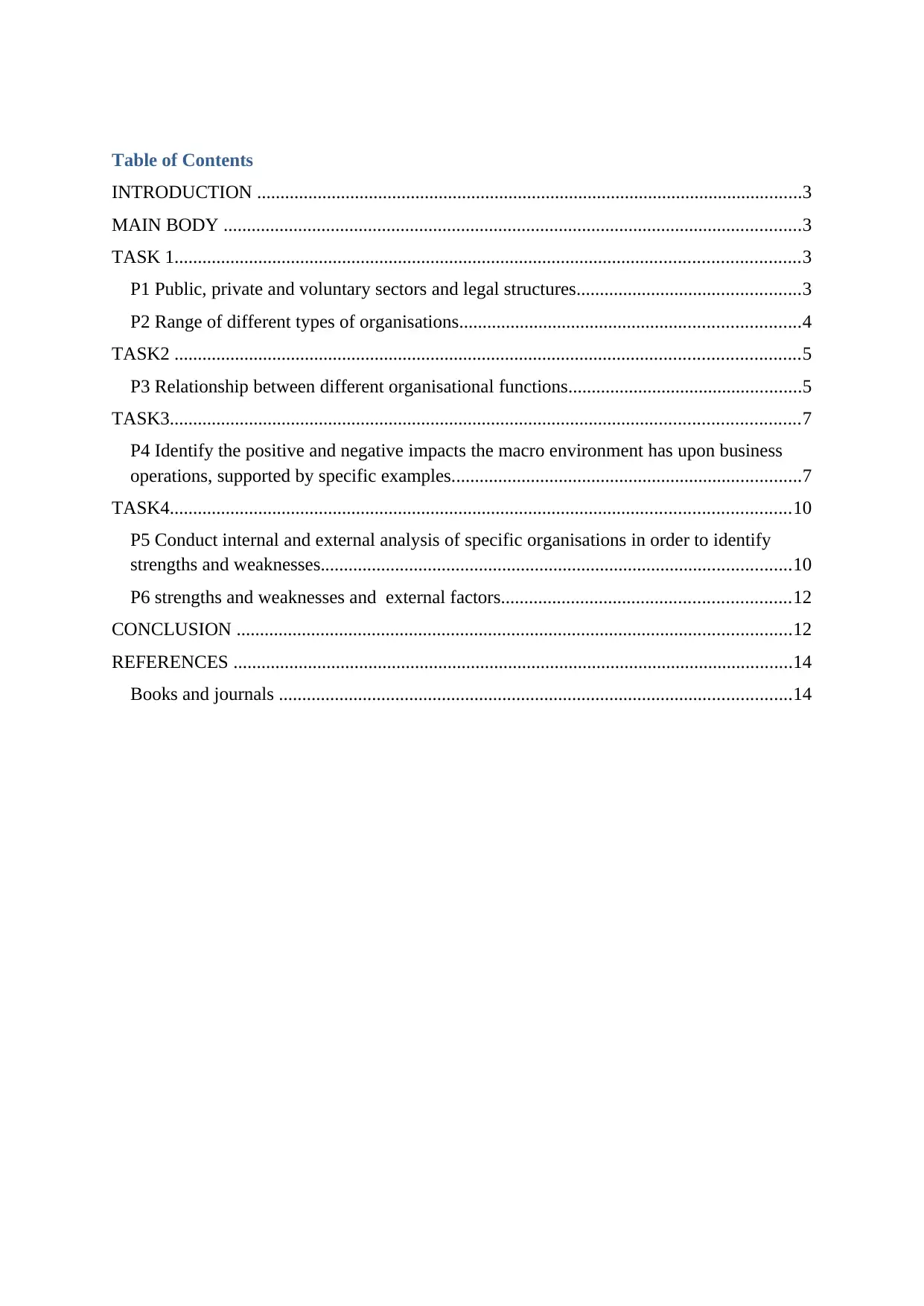
Table of Contents
INTRODUCTION .....................................................................................................................3
MAIN BODY ............................................................................................................................3
TASK 1......................................................................................................................................3
P1 Public, private and voluntary sectors and legal structures................................................3
P2 Range of different types of organisations.........................................................................4
TASK2 ......................................................................................................................................5
P3 Relationship between different organisational functions..................................................5
TASK3.......................................................................................................................................7
P4 Identify the positive and negative impacts the macro environment has upon business
operations, supported by specific examples...........................................................................7
TASK4.....................................................................................................................................10
P5 Conduct internal and external analysis of specific organisations in order to identify
strengths and weaknesses.....................................................................................................10
P6 strengths and weaknesses and external factors..............................................................12
CONCLUSION .......................................................................................................................12
REFERENCES ........................................................................................................................14
Books and journals ..............................................................................................................14
INTRODUCTION .....................................................................................................................3
MAIN BODY ............................................................................................................................3
TASK 1......................................................................................................................................3
P1 Public, private and voluntary sectors and legal structures................................................3
P2 Range of different types of organisations.........................................................................4
TASK2 ......................................................................................................................................5
P3 Relationship between different organisational functions..................................................5
TASK3.......................................................................................................................................7
P4 Identify the positive and negative impacts the macro environment has upon business
operations, supported by specific examples...........................................................................7
TASK4.....................................................................................................................................10
P5 Conduct internal and external analysis of specific organisations in order to identify
strengths and weaknesses.....................................................................................................10
P6 strengths and weaknesses and external factors..............................................................12
CONCLUSION .......................................................................................................................12
REFERENCES ........................................................................................................................14
Books and journals ..............................................................................................................14
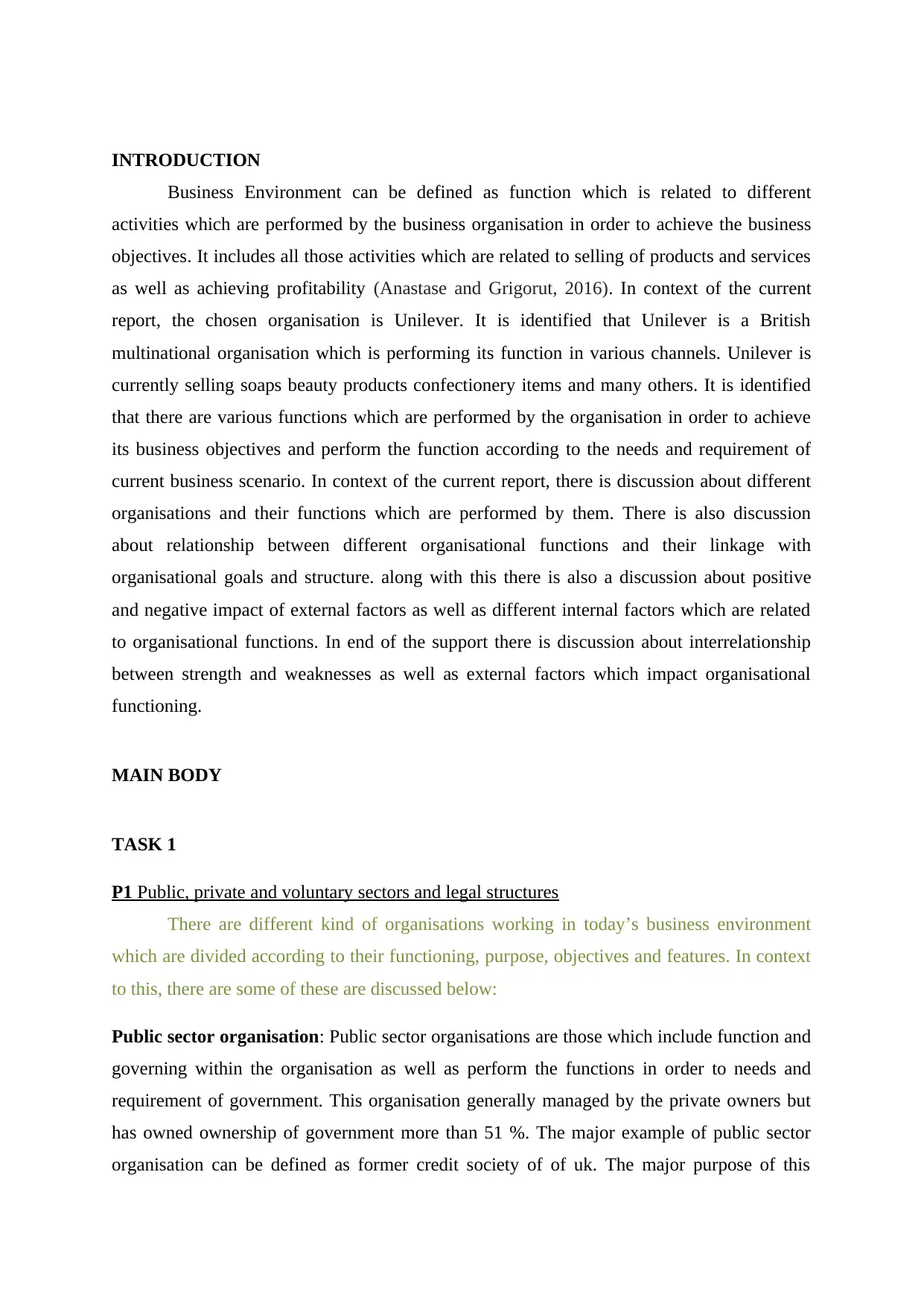
INTRODUCTION
Business Environment can be defined as function which is related to different
activities which are performed by the business organisation in order to achieve the business
objectives. It includes all those activities which are related to selling of products and services
as well as achieving profitability (Anastase and Grigorut, 2016). In context of the current
report, the chosen organisation is Unilever. It is identified that Unilever is a British
multinational organisation which is performing its function in various channels. Unilever is
currently selling soaps beauty products confectionery items and many others. It is identified
that there are various functions which are performed by the organisation in order to achieve
its business objectives and perform the function according to the needs and requirement of
current business scenario. In context of the current report, there is discussion about different
organisations and their functions which are performed by them. There is also discussion
about relationship between different organisational functions and their linkage with
organisational goals and structure. along with this there is also a discussion about positive
and negative impact of external factors as well as different internal factors which are related
to organisational functions. In end of the support there is discussion about interrelationship
between strength and weaknesses as well as external factors which impact organisational
functioning.
MAIN BODY
TASK 1
P1 Public, private and voluntary sectors and legal structures
There are different kind of organisations working in today’s business environment
which are divided according to their functioning, purpose, objectives and features. In context
to this, there are some of these are discussed below:
Public sector organisation: Public sector organisations are those which include function and
governing within the organisation as well as perform the functions in order to needs and
requirement of government. This organisation generally managed by the private owners but
has owned ownership of government more than 51 %. The major example of public sector
organisation can be defined as former credit society of of uk. The major purpose of this
Business Environment can be defined as function which is related to different
activities which are performed by the business organisation in order to achieve the business
objectives. It includes all those activities which are related to selling of products and services
as well as achieving profitability (Anastase and Grigorut, 2016). In context of the current
report, the chosen organisation is Unilever. It is identified that Unilever is a British
multinational organisation which is performing its function in various channels. Unilever is
currently selling soaps beauty products confectionery items and many others. It is identified
that there are various functions which are performed by the organisation in order to achieve
its business objectives and perform the function according to the needs and requirement of
current business scenario. In context of the current report, there is discussion about different
organisations and their functions which are performed by them. There is also discussion
about relationship between different organisational functions and their linkage with
organisational goals and structure. along with this there is also a discussion about positive
and negative impact of external factors as well as different internal factors which are related
to organisational functions. In end of the support there is discussion about interrelationship
between strength and weaknesses as well as external factors which impact organisational
functioning.
MAIN BODY
TASK 1
P1 Public, private and voluntary sectors and legal structures
There are different kind of organisations working in today’s business environment
which are divided according to their functioning, purpose, objectives and features. In context
to this, there are some of these are discussed below:
Public sector organisation: Public sector organisations are those which include function and
governing within the organisation as well as perform the functions in order to needs and
requirement of government. This organisation generally managed by the private owners but
has owned ownership of government more than 51 %. The major example of public sector
organisation can be defined as former credit society of of uk. The major purpose of this
⊘ This is a preview!⊘
Do you want full access?
Subscribe today to unlock all pages.

Trusted by 1+ million students worldwide
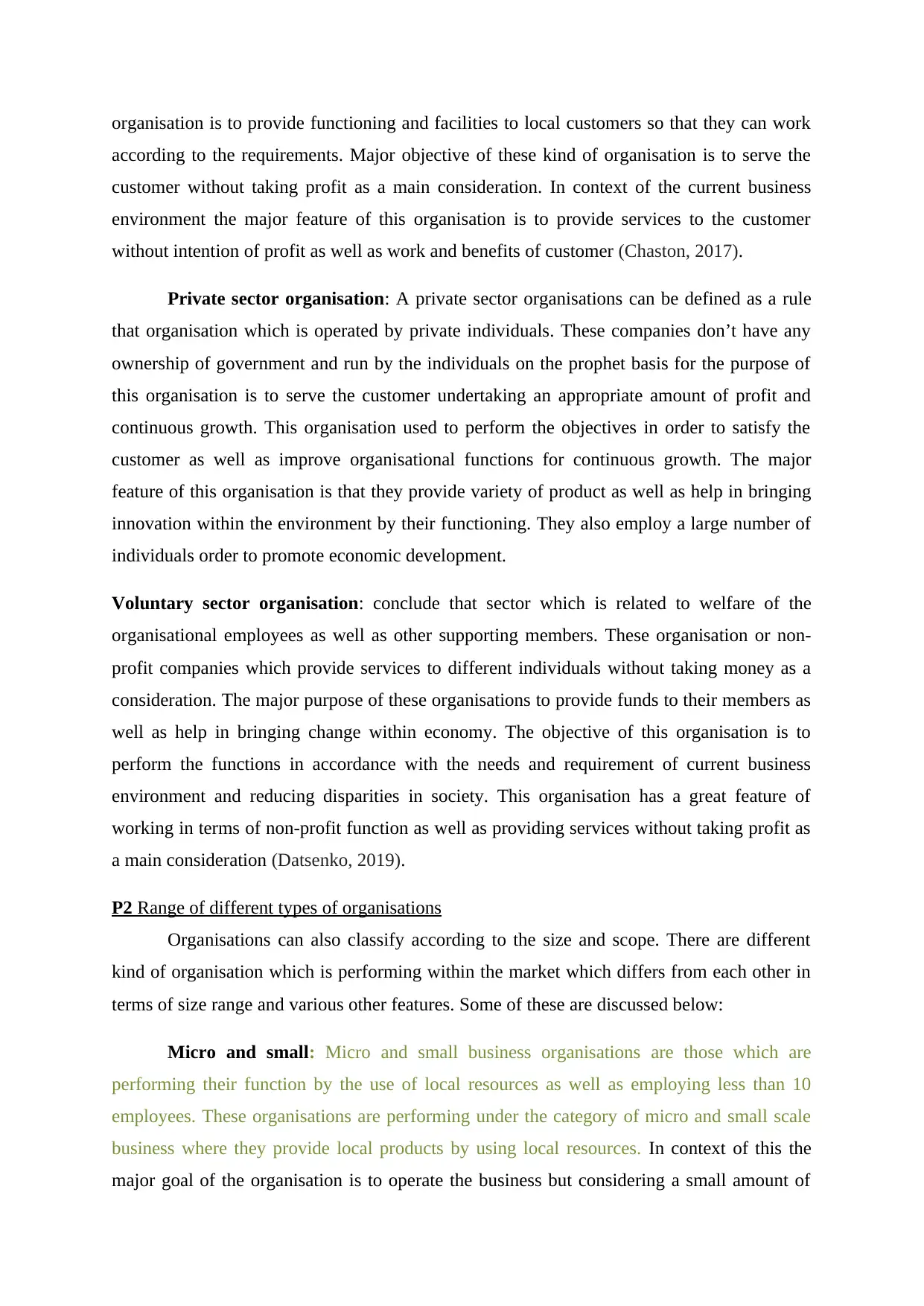
organisation is to provide functioning and facilities to local customers so that they can work
according to the requirements. Major objective of these kind of organisation is to serve the
customer without taking profit as a main consideration. In context of the current business
environment the major feature of this organisation is to provide services to the customer
without intention of profit as well as work and benefits of customer (Chaston, 2017).
Private sector organisation: A private sector organisations can be defined as a rule
that organisation which is operated by private individuals. These companies don’t have any
ownership of government and run by the individuals on the prophet basis for the purpose of
this organisation is to serve the customer undertaking an appropriate amount of profit and
continuous growth. This organisation used to perform the objectives in order to satisfy the
customer as well as improve organisational functions for continuous growth. The major
feature of this organisation is that they provide variety of product as well as help in bringing
innovation within the environment by their functioning. They also employ a large number of
individuals order to promote economic development.
Voluntary sector organisation: conclude that sector which is related to welfare of the
organisational employees as well as other supporting members. These organisation or non-
profit companies which provide services to different individuals without taking money as a
consideration. The major purpose of these organisations to provide funds to their members as
well as help in bringing change within economy. The objective of this organisation is to
perform the functions in accordance with the needs and requirement of current business
environment and reducing disparities in society. This organisation has a great feature of
working in terms of non-profit function as well as providing services without taking profit as
a main consideration (Datsenko, 2019).
P2 Range of different types of organisations
Organisations can also classify according to the size and scope. There are different
kind of organisation which is performing within the market which differs from each other in
terms of size range and various other features. Some of these are discussed below:
Micro and small: Micro and small business organisations are those which are
performing their function by the use of local resources as well as employing less than 10
employees. These organisations are performing under the category of micro and small scale
business where they provide local products by using local resources. In context of this the
major goal of the organisation is to operate the business but considering a small amount of
according to the requirements. Major objective of these kind of organisation is to serve the
customer without taking profit as a main consideration. In context of the current business
environment the major feature of this organisation is to provide services to the customer
without intention of profit as well as work and benefits of customer (Chaston, 2017).
Private sector organisation: A private sector organisations can be defined as a rule
that organisation which is operated by private individuals. These companies don’t have any
ownership of government and run by the individuals on the prophet basis for the purpose of
this organisation is to serve the customer undertaking an appropriate amount of profit and
continuous growth. This organisation used to perform the objectives in order to satisfy the
customer as well as improve organisational functions for continuous growth. The major
feature of this organisation is that they provide variety of product as well as help in bringing
innovation within the environment by their functioning. They also employ a large number of
individuals order to promote economic development.
Voluntary sector organisation: conclude that sector which is related to welfare of the
organisational employees as well as other supporting members. These organisation or non-
profit companies which provide services to different individuals without taking money as a
consideration. The major purpose of these organisations to provide funds to their members as
well as help in bringing change within economy. The objective of this organisation is to
perform the functions in accordance with the needs and requirement of current business
environment and reducing disparities in society. This organisation has a great feature of
working in terms of non-profit function as well as providing services without taking profit as
a main consideration (Datsenko, 2019).
P2 Range of different types of organisations
Organisations can also classify according to the size and scope. There are different
kind of organisation which is performing within the market which differs from each other in
terms of size range and various other features. Some of these are discussed below:
Micro and small: Micro and small business organisations are those which are
performing their function by the use of local resources as well as employing less than 10
employees. These organisations are performing under the category of micro and small scale
business where they provide local products by using local resources. In context of this the
major goal of the organisation is to operate the business but considering a small amount of
Paraphrase This Document
Need a fresh take? Get an instant paraphrase of this document with our AI Paraphraser
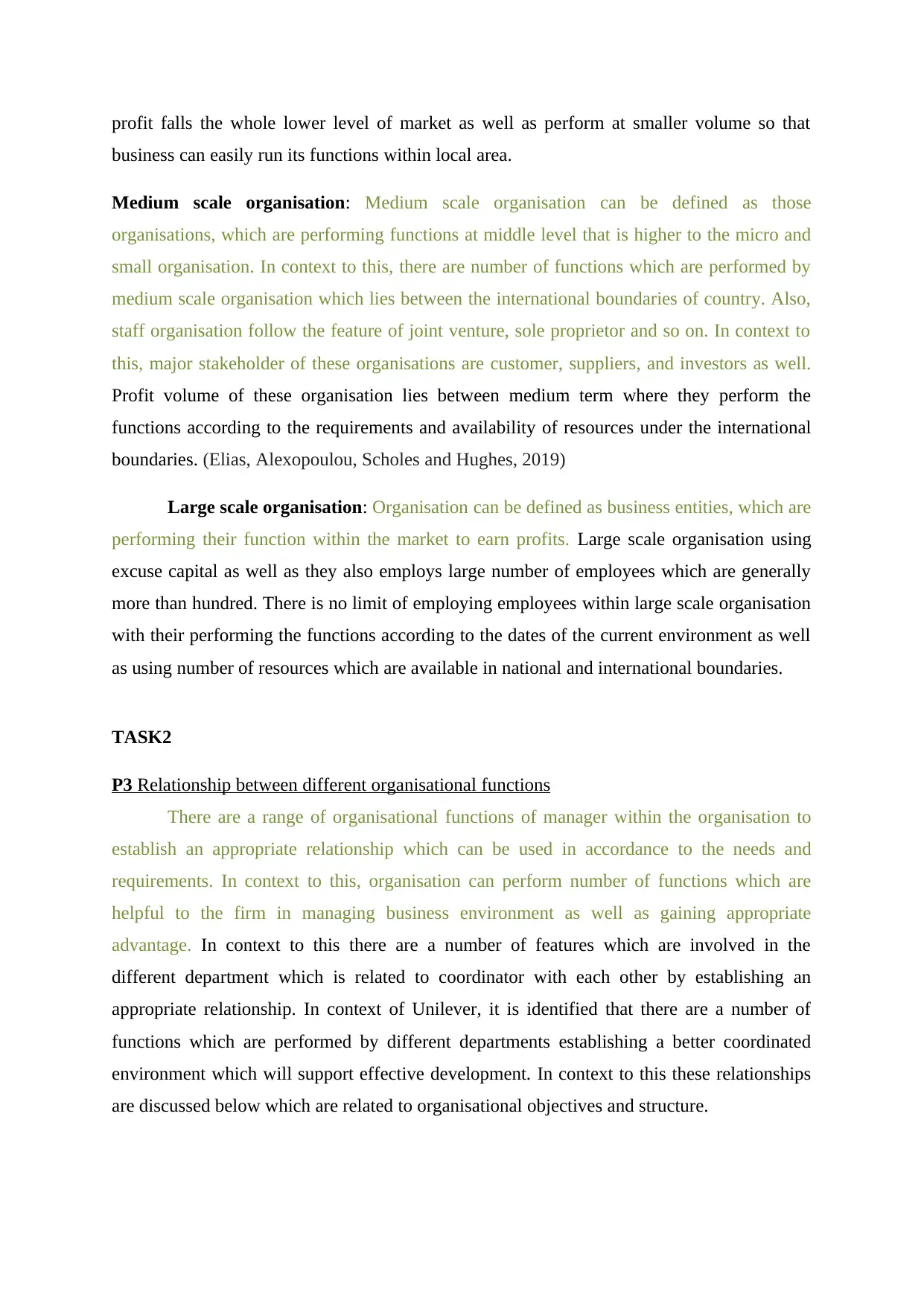
profit falls the whole lower level of market as well as perform at smaller volume so that
business can easily run its functions within local area.
Medium scale organisation: Medium scale organisation can be defined as those
organisations, which are performing functions at middle level that is higher to the micro and
small organisation. In context to this, there are number of functions which are performed by
medium scale organisation which lies between the international boundaries of country. Also,
staff organisation follow the feature of joint venture, sole proprietor and so on. In context to
this, major stakeholder of these organisations are customer, suppliers, and investors as well.
Profit volume of these organisation lies between medium term where they perform the
functions according to the requirements and availability of resources under the international
boundaries. (Elias, Alexopoulou, Scholes and Hughes, 2019)
Large scale organisation: Organisation can be defined as business entities, which are
performing their function within the market to earn profits. Large scale organisation using
excuse capital as well as they also employs large number of employees which are generally
more than hundred. There is no limit of employing employees within large scale organisation
with their performing the functions according to the dates of the current environment as well
as using number of resources which are available in national and international boundaries.
TASK2
P3 Relationship between different organisational functions
There are a range of organisational functions of manager within the organisation to
establish an appropriate relationship which can be used in accordance to the needs and
requirements. In context to this, organisation can perform number of functions which are
helpful to the firm in managing business environment as well as gaining appropriate
advantage. In context to this there are a number of features which are involved in the
different department which is related to coordinator with each other by establishing an
appropriate relationship. In context of Unilever, it is identified that there are a number of
functions which are performed by different departments establishing a better coordinated
environment which will support effective development. In context to this these relationships
are discussed below which are related to organisational objectives and structure.
business can easily run its functions within local area.
Medium scale organisation: Medium scale organisation can be defined as those
organisations, which are performing functions at middle level that is higher to the micro and
small organisation. In context to this, there are number of functions which are performed by
medium scale organisation which lies between the international boundaries of country. Also,
staff organisation follow the feature of joint venture, sole proprietor and so on. In context to
this, major stakeholder of these organisations are customer, suppliers, and investors as well.
Profit volume of these organisation lies between medium term where they perform the
functions according to the requirements and availability of resources under the international
boundaries. (Elias, Alexopoulou, Scholes and Hughes, 2019)
Large scale organisation: Organisation can be defined as business entities, which are
performing their function within the market to earn profits. Large scale organisation using
excuse capital as well as they also employs large number of employees which are generally
more than hundred. There is no limit of employing employees within large scale organisation
with their performing the functions according to the dates of the current environment as well
as using number of resources which are available in national and international boundaries.
TASK2
P3 Relationship between different organisational functions
There are a range of organisational functions of manager within the organisation to
establish an appropriate relationship which can be used in accordance to the needs and
requirements. In context to this, organisation can perform number of functions which are
helpful to the firm in managing business environment as well as gaining appropriate
advantage. In context to this there are a number of features which are involved in the
different department which is related to coordinator with each other by establishing an
appropriate relationship. In context of Unilever, it is identified that there are a number of
functions which are performed by different departments establishing a better coordinated
environment which will support effective development. In context to this these relationships
are discussed below which are related to organisational objectives and structure.
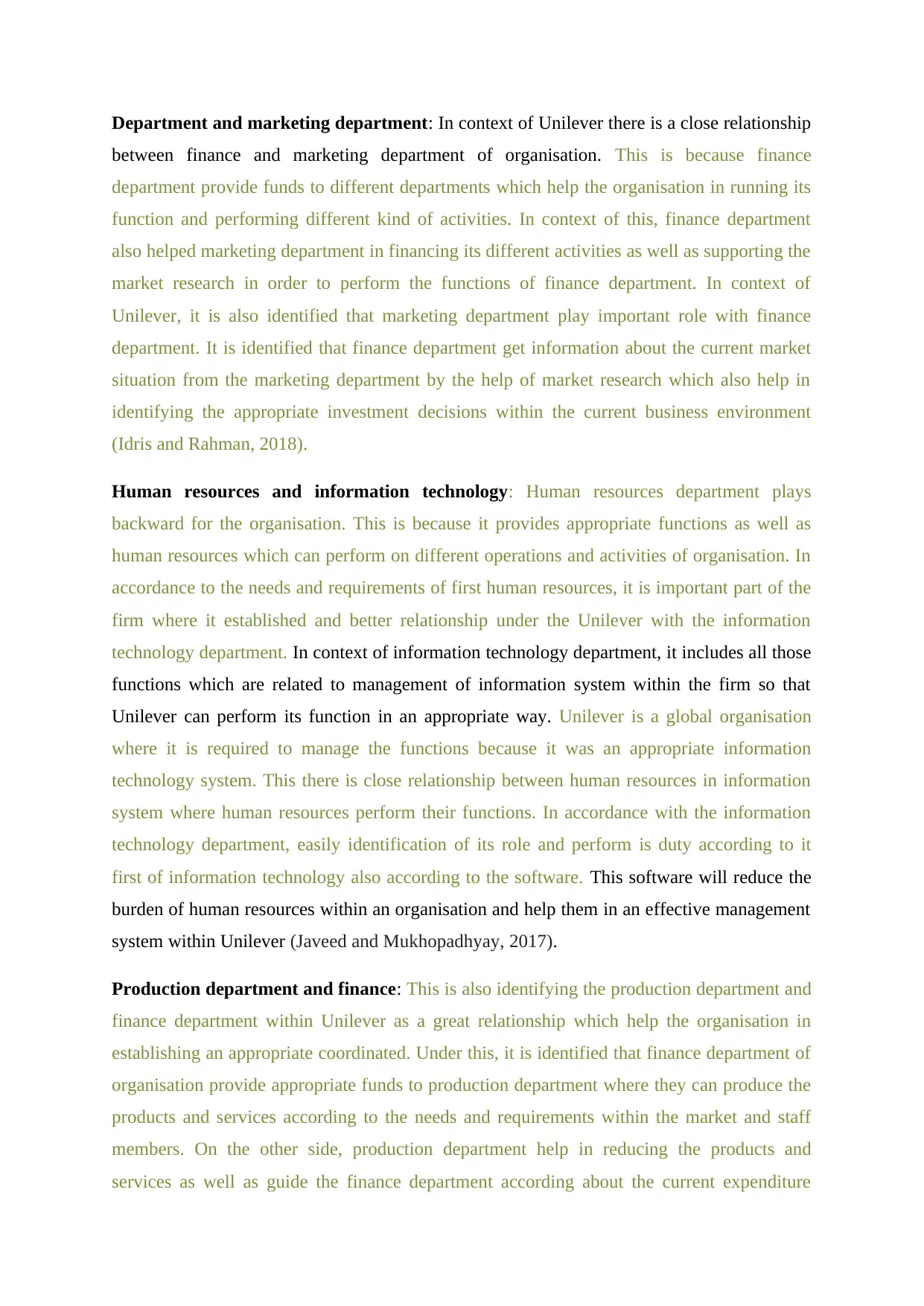
Department and marketing department: In context of Unilever there is a close relationship
between finance and marketing department of organisation. This is because finance
department provide funds to different departments which help the organisation in running its
function and performing different kind of activities. In context of this, finance department
also helped marketing department in financing its different activities as well as supporting the
market research in order to perform the functions of finance department. In context of
Unilever, it is also identified that marketing department play important role with finance
department. It is identified that finance department get information about the current market
situation from the marketing department by the help of market research which also help in
identifying the appropriate investment decisions within the current business environment
(Idris and Rahman, 2018).
Human resources and information technology: Human resources department plays
backward for the organisation. This is because it provides appropriate functions as well as
human resources which can perform on different operations and activities of organisation. In
accordance to the needs and requirements of first human resources, it is important part of the
firm where it established and better relationship under the Unilever with the information
technology department. In context of information technology department, it includes all those
functions which are related to management of information system within the firm so that
Unilever can perform its function in an appropriate way. Unilever is a global organisation
where it is required to manage the functions because it was an appropriate information
technology system. This there is close relationship between human resources in information
system where human resources perform their functions. In accordance with the information
technology department, easily identification of its role and perform is duty according to it
first of information technology also according to the software. This software will reduce the
burden of human resources within an organisation and help them in an effective management
system within Unilever (Javeed and Mukhopadhyay, 2017).
Production department and finance: This is also identifying the production department and
finance department within Unilever as a great relationship which help the organisation in
establishing an appropriate coordinated. Under this, it is identified that finance department of
organisation provide appropriate funds to production department where they can produce the
products and services according to the needs and requirements within the market and staff
members. On the other side, production department help in reducing the products and
services as well as guide the finance department according about the current expenditure
between finance and marketing department of organisation. This is because finance
department provide funds to different departments which help the organisation in running its
function and performing different kind of activities. In context of this, finance department
also helped marketing department in financing its different activities as well as supporting the
market research in order to perform the functions of finance department. In context of
Unilever, it is also identified that marketing department play important role with finance
department. It is identified that finance department get information about the current market
situation from the marketing department by the help of market research which also help in
identifying the appropriate investment decisions within the current business environment
(Idris and Rahman, 2018).
Human resources and information technology: Human resources department plays
backward for the organisation. This is because it provides appropriate functions as well as
human resources which can perform on different operations and activities of organisation. In
accordance to the needs and requirements of first human resources, it is important part of the
firm where it established and better relationship under the Unilever with the information
technology department. In context of information technology department, it includes all those
functions which are related to management of information system within the firm so that
Unilever can perform its function in an appropriate way. Unilever is a global organisation
where it is required to manage the functions because it was an appropriate information
technology system. This there is close relationship between human resources in information
system where human resources perform their functions. In accordance with the information
technology department, easily identification of its role and perform is duty according to it
first of information technology also according to the software. This software will reduce the
burden of human resources within an organisation and help them in an effective management
system within Unilever (Javeed and Mukhopadhyay, 2017).
Production department and finance: This is also identifying the production department and
finance department within Unilever as a great relationship which help the organisation in
establishing an appropriate coordinated. Under this, it is identified that finance department of
organisation provide appropriate funds to production department where they can produce the
products and services according to the needs and requirements within the market and staff
members. On the other side, production department help in reducing the products and
services as well as guide the finance department according about the current expenditure
⊘ This is a preview!⊘
Do you want full access?
Subscribe today to unlock all pages.

Trusted by 1+ million students worldwide
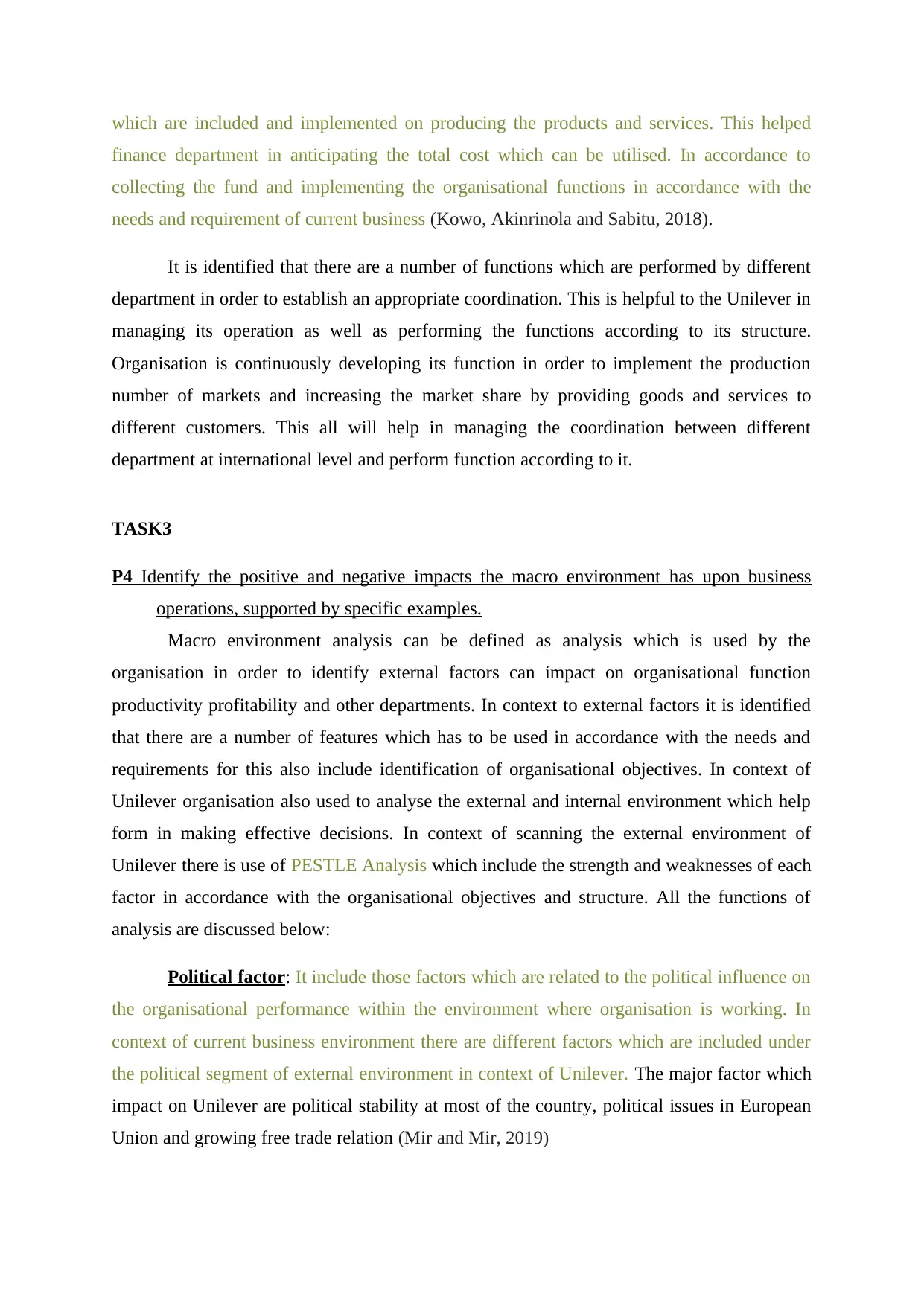
which are included and implemented on producing the products and services. This helped
finance department in anticipating the total cost which can be utilised. In accordance to
collecting the fund and implementing the organisational functions in accordance with the
needs and requirement of current business (Kowo, Akinrinola and Sabitu, 2018).
It is identified that there are a number of functions which are performed by different
department in order to establish an appropriate coordination. This is helpful to the Unilever in
managing its operation as well as performing the functions according to its structure.
Organisation is continuously developing its function in order to implement the production
number of markets and increasing the market share by providing goods and services to
different customers. This all will help in managing the coordination between different
department at international level and perform function according to it.
TASK3
P4 Identify the positive and negative impacts the macro environment has upon business
operations, supported by specific examples.
Macro environment analysis can be defined as analysis which is used by the
organisation in order to identify external factors can impact on organisational function
productivity profitability and other departments. In context to external factors it is identified
that there are a number of features which has to be used in accordance with the needs and
requirements for this also include identification of organisational objectives. In context of
Unilever organisation also used to analyse the external and internal environment which help
form in making effective decisions. In context of scanning the external environment of
Unilever there is use of PESTLE Analysis which include the strength and weaknesses of each
factor in accordance with the organisational objectives and structure. All the functions of
analysis are discussed below:
Political factor: It include those factors which are related to the political influence on
the organisational performance within the environment where organisation is working. In
context of current business environment there are different factors which are included under
the political segment of external environment in context of Unilever. The major factor which
impact on Unilever are political stability at most of the country, political issues in European
Union and growing free trade relation (Mir and Mir, 2019)
finance department in anticipating the total cost which can be utilised. In accordance to
collecting the fund and implementing the organisational functions in accordance with the
needs and requirement of current business (Kowo, Akinrinola and Sabitu, 2018).
It is identified that there are a number of functions which are performed by different
department in order to establish an appropriate coordination. This is helpful to the Unilever in
managing its operation as well as performing the functions according to its structure.
Organisation is continuously developing its function in order to implement the production
number of markets and increasing the market share by providing goods and services to
different customers. This all will help in managing the coordination between different
department at international level and perform function according to it.
TASK3
P4 Identify the positive and negative impacts the macro environment has upon business
operations, supported by specific examples.
Macro environment analysis can be defined as analysis which is used by the
organisation in order to identify external factors can impact on organisational function
productivity profitability and other departments. In context to external factors it is identified
that there are a number of features which has to be used in accordance with the needs and
requirements for this also include identification of organisational objectives. In context of
Unilever organisation also used to analyse the external and internal environment which help
form in making effective decisions. In context of scanning the external environment of
Unilever there is use of PESTLE Analysis which include the strength and weaknesses of each
factor in accordance with the organisational objectives and structure. All the functions of
analysis are discussed below:
Political factor: It include those factors which are related to the political influence on
the organisational performance within the environment where organisation is working. In
context of current business environment there are different factors which are included under
the political segment of external environment in context of Unilever. The major factor which
impact on Unilever are political stability at most of the country, political issues in European
Union and growing free trade relation (Mir and Mir, 2019)
Paraphrase This Document
Need a fresh take? Get an instant paraphrase of this document with our AI Paraphraser
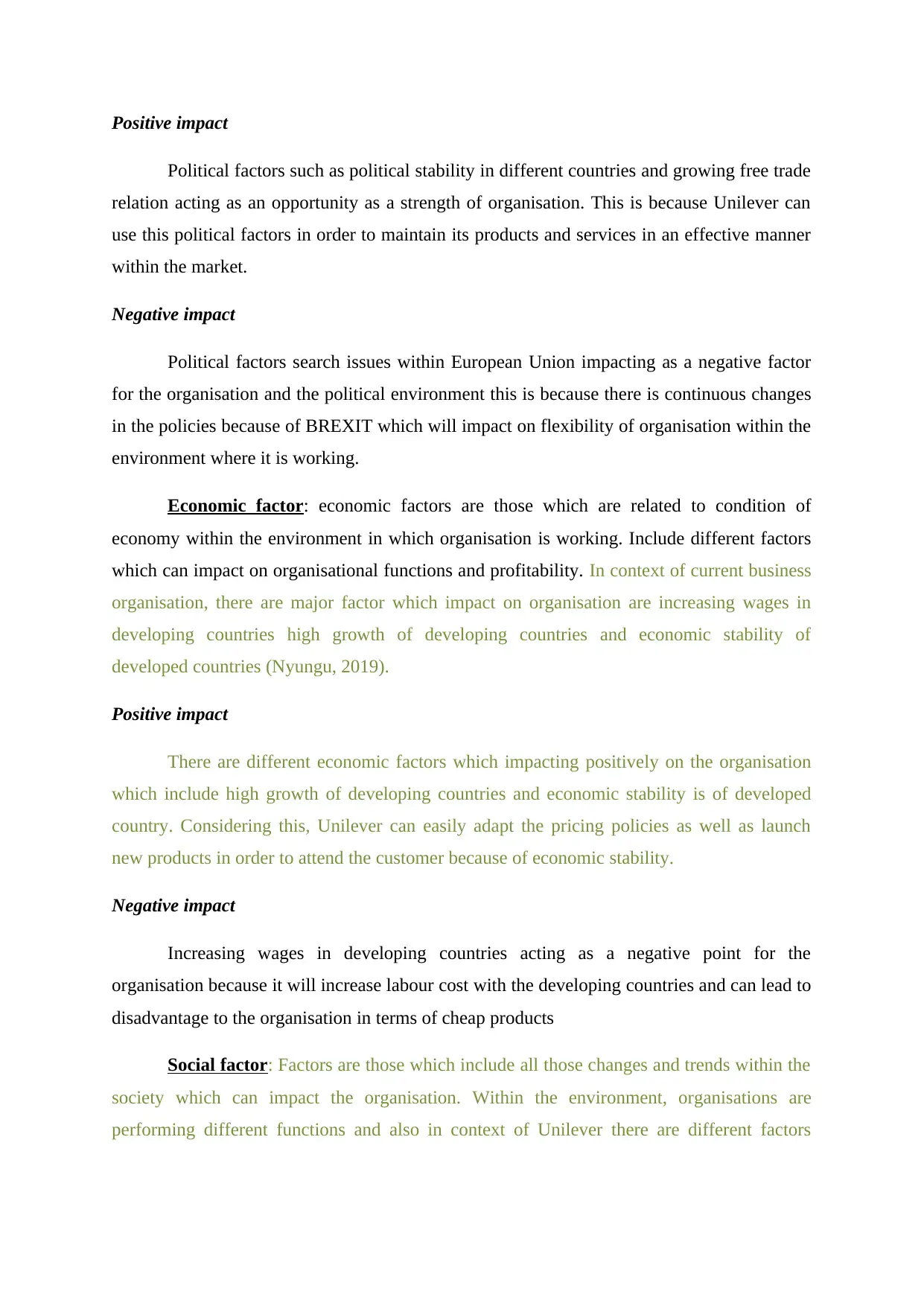
Positive impact
Political factors such as political stability in different countries and growing free trade
relation acting as an opportunity as a strength of organisation. This is because Unilever can
use this political factors in order to maintain its products and services in an effective manner
within the market.
Negative impact
Political factors search issues within European Union impacting as a negative factor
for the organisation and the political environment this is because there is continuous changes
in the policies because of BREXIT which will impact on flexibility of organisation within the
environment where it is working.
Economic factor: economic factors are those which are related to condition of
economy within the environment in which organisation is working. Include different factors
which can impact on organisational functions and profitability. In context of current business
organisation, there are major factor which impact on organisation are increasing wages in
developing countries high growth of developing countries and economic stability of
developed countries (Nyungu, 2019).
Positive impact
There are different economic factors which impacting positively on the organisation
which include high growth of developing countries and economic stability is of developed
country. Considering this, Unilever can easily adapt the pricing policies as well as launch
new products in order to attend the customer because of economic stability.
Negative impact
Increasing wages in developing countries acting as a negative point for the
organisation because it will increase labour cost with the developing countries and can lead to
disadvantage to the organisation in terms of cheap products
Social factor: Factors are those which include all those changes and trends within the
society which can impact the organisation. Within the environment, organisations are
performing different functions and also in context of Unilever there are different factors
Political factors such as political stability in different countries and growing free trade
relation acting as an opportunity as a strength of organisation. This is because Unilever can
use this political factors in order to maintain its products and services in an effective manner
within the market.
Negative impact
Political factors search issues within European Union impacting as a negative factor
for the organisation and the political environment this is because there is continuous changes
in the policies because of BREXIT which will impact on flexibility of organisation within the
environment where it is working.
Economic factor: economic factors are those which are related to condition of
economy within the environment in which organisation is working. Include different factors
which can impact on organisational functions and profitability. In context of current business
organisation, there are major factor which impact on organisation are increasing wages in
developing countries high growth of developing countries and economic stability of
developed countries (Nyungu, 2019).
Positive impact
There are different economic factors which impacting positively on the organisation
which include high growth of developing countries and economic stability is of developed
country. Considering this, Unilever can easily adapt the pricing policies as well as launch
new products in order to attend the customer because of economic stability.
Negative impact
Increasing wages in developing countries acting as a negative point for the
organisation because it will increase labour cost with the developing countries and can lead to
disadvantage to the organisation in terms of cheap products
Social factor: Factors are those which include all those changes and trends within the
society which can impact the organisation. Within the environment, organisations are
performing different functions and also in context of Unilever there are different factors
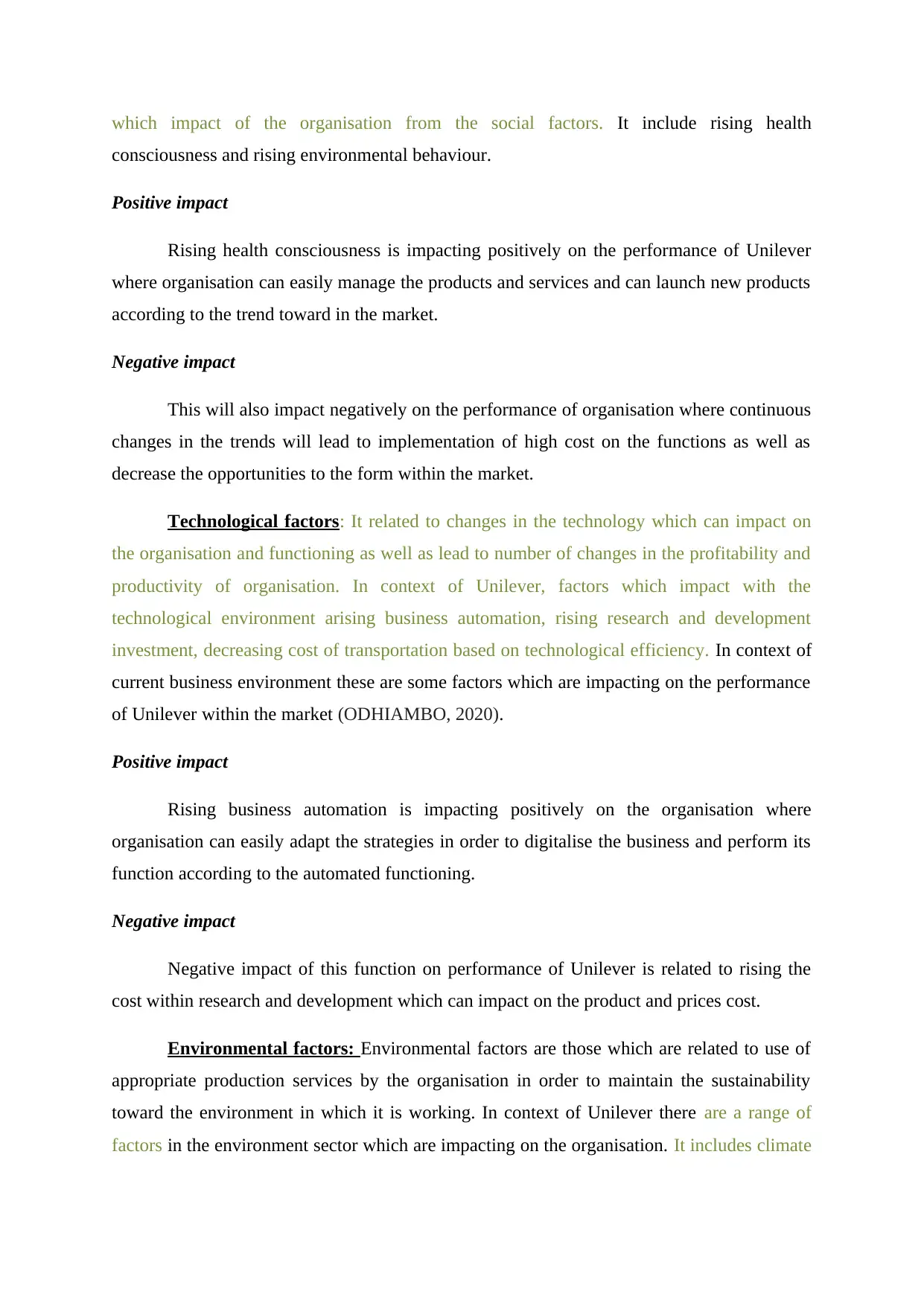
which impact of the organisation from the social factors. It include rising health
consciousness and rising environmental behaviour.
Positive impact
Rising health consciousness is impacting positively on the performance of Unilever
where organisation can easily manage the products and services and can launch new products
according to the trend toward in the market.
Negative impact
This will also impact negatively on the performance of organisation where continuous
changes in the trends will lead to implementation of high cost on the functions as well as
decrease the opportunities to the form within the market.
Technological factors: It related to changes in the technology which can impact on
the organisation and functioning as well as lead to number of changes in the profitability and
productivity of organisation. In context of Unilever, factors which impact with the
technological environment arising business automation, rising research and development
investment, decreasing cost of transportation based on technological efficiency. In context of
current business environment these are some factors which are impacting on the performance
of Unilever within the market (ODHIAMBO, 2020).
Positive impact
Rising business automation is impacting positively on the organisation where
organisation can easily adapt the strategies in order to digitalise the business and perform its
function according to the automated functioning.
Negative impact
Negative impact of this function on performance of Unilever is related to rising the
cost within research and development which can impact on the product and prices cost.
Environmental factors: Environmental factors are those which are related to use of
appropriate production services by the organisation in order to maintain the sustainability
toward the environment in which it is working. In context of Unilever there are a range of
factors in the environment sector which are impacting on the organisation. It includes climate
consciousness and rising environmental behaviour.
Positive impact
Rising health consciousness is impacting positively on the performance of Unilever
where organisation can easily manage the products and services and can launch new products
according to the trend toward in the market.
Negative impact
This will also impact negatively on the performance of organisation where continuous
changes in the trends will lead to implementation of high cost on the functions as well as
decrease the opportunities to the form within the market.
Technological factors: It related to changes in the technology which can impact on
the organisation and functioning as well as lead to number of changes in the profitability and
productivity of organisation. In context of Unilever, factors which impact with the
technological environment arising business automation, rising research and development
investment, decreasing cost of transportation based on technological efficiency. In context of
current business environment these are some factors which are impacting on the performance
of Unilever within the market (ODHIAMBO, 2020).
Positive impact
Rising business automation is impacting positively on the organisation where
organisation can easily adapt the strategies in order to digitalise the business and perform its
function according to the automated functioning.
Negative impact
Negative impact of this function on performance of Unilever is related to rising the
cost within research and development which can impact on the product and prices cost.
Environmental factors: Environmental factors are those which are related to use of
appropriate production services by the organisation in order to maintain the sustainability
toward the environment in which it is working. In context of Unilever there are a range of
factors in the environment sector which are impacting on the organisation. It includes climate
⊘ This is a preview!⊘
Do you want full access?
Subscribe today to unlock all pages.

Trusted by 1+ million students worldwide
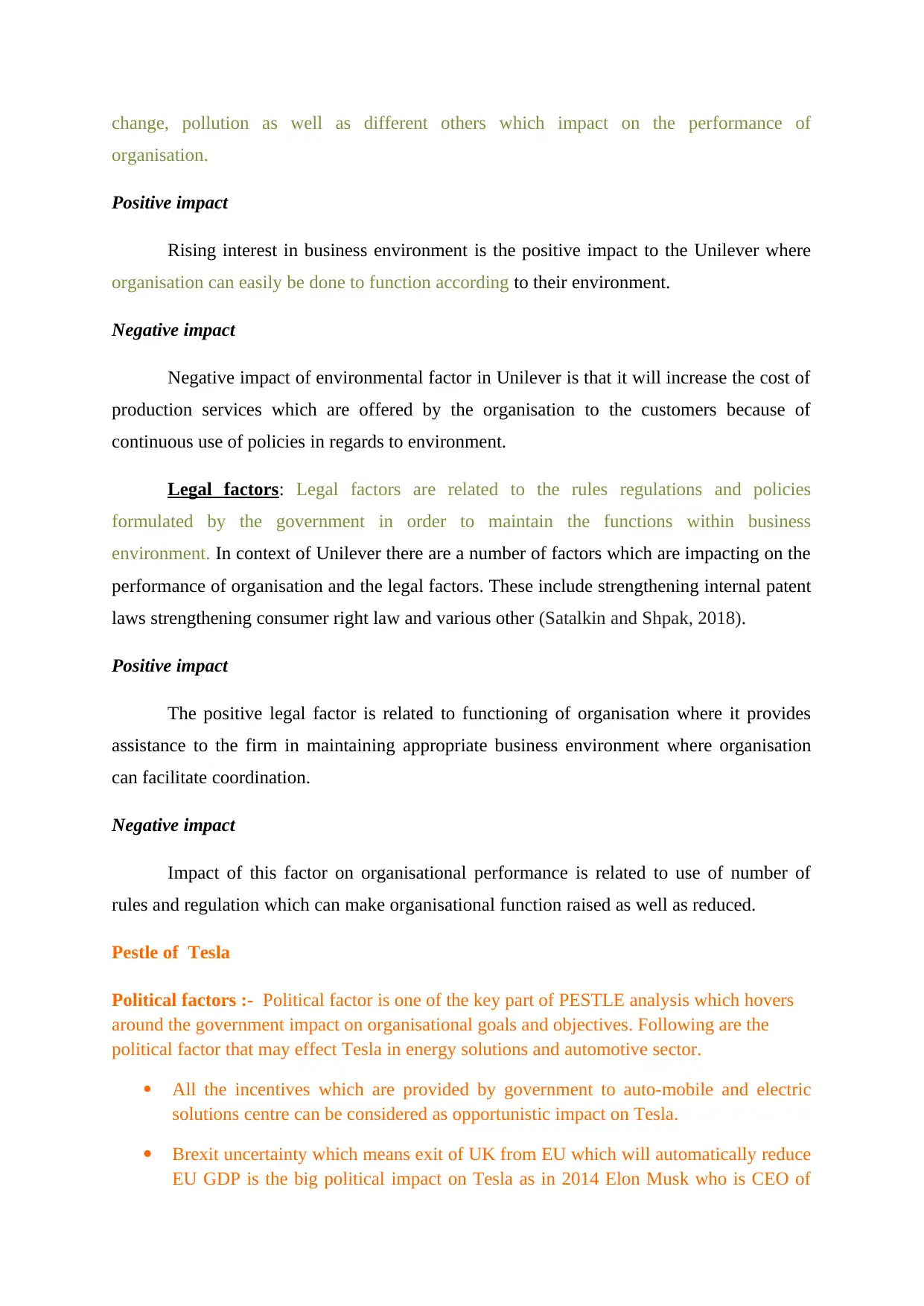
change, pollution as well as different others which impact on the performance of
organisation.
Positive impact
Rising interest in business environment is the positive impact to the Unilever where
organisation can easily be done to function according to their environment.
Negative impact
Negative impact of environmental factor in Unilever is that it will increase the cost of
production services which are offered by the organisation to the customers because of
continuous use of policies in regards to environment.
Legal factors: Legal factors are related to the rules regulations and policies
formulated by the government in order to maintain the functions within business
environment. In context of Unilever there are a number of factors which are impacting on the
performance of organisation and the legal factors. These include strengthening internal patent
laws strengthening consumer right law and various other (Satalkin and Shpak, 2018).
Positive impact
The positive legal factor is related to functioning of organisation where it provides
assistance to the firm in maintaining appropriate business environment where organisation
can facilitate coordination.
Negative impact
Impact of this factor on organisational performance is related to use of number of
rules and regulation which can make organisational function raised as well as reduced.
Pestle of Tesla
Political factors :- Political factor is one of the key part of PESTLE analysis which hovers
around the government impact on organisational goals and objectives. Following are the
political factor that may effect Tesla in energy solutions and automotive sector.
All the incentives which are provided by government to auto-mobile and electric
solutions centre can be considered as opportunistic impact on Tesla.
Brexit uncertainty which means exit of UK from EU which will automatically reduce
EU GDP is the big political impact on Tesla as in 2014 Elon Musk who is CEO of
organisation.
Positive impact
Rising interest in business environment is the positive impact to the Unilever where
organisation can easily be done to function according to their environment.
Negative impact
Negative impact of environmental factor in Unilever is that it will increase the cost of
production services which are offered by the organisation to the customers because of
continuous use of policies in regards to environment.
Legal factors: Legal factors are related to the rules regulations and policies
formulated by the government in order to maintain the functions within business
environment. In context of Unilever there are a number of factors which are impacting on the
performance of organisation and the legal factors. These include strengthening internal patent
laws strengthening consumer right law and various other (Satalkin and Shpak, 2018).
Positive impact
The positive legal factor is related to functioning of organisation where it provides
assistance to the firm in maintaining appropriate business environment where organisation
can facilitate coordination.
Negative impact
Impact of this factor on organisational performance is related to use of number of
rules and regulation which can make organisational function raised as well as reduced.
Pestle of Tesla
Political factors :- Political factor is one of the key part of PESTLE analysis which hovers
around the government impact on organisational goals and objectives. Following are the
political factor that may effect Tesla in energy solutions and automotive sector.
All the incentives which are provided by government to auto-mobile and electric
solutions centre can be considered as opportunistic impact on Tesla.
Brexit uncertainty which means exit of UK from EU which will automatically reduce
EU GDP is the big political impact on Tesla as in 2014 Elon Musk who is CEO of
Paraphrase This Document
Need a fresh take? Get an instant paraphrase of this document with our AI Paraphraser
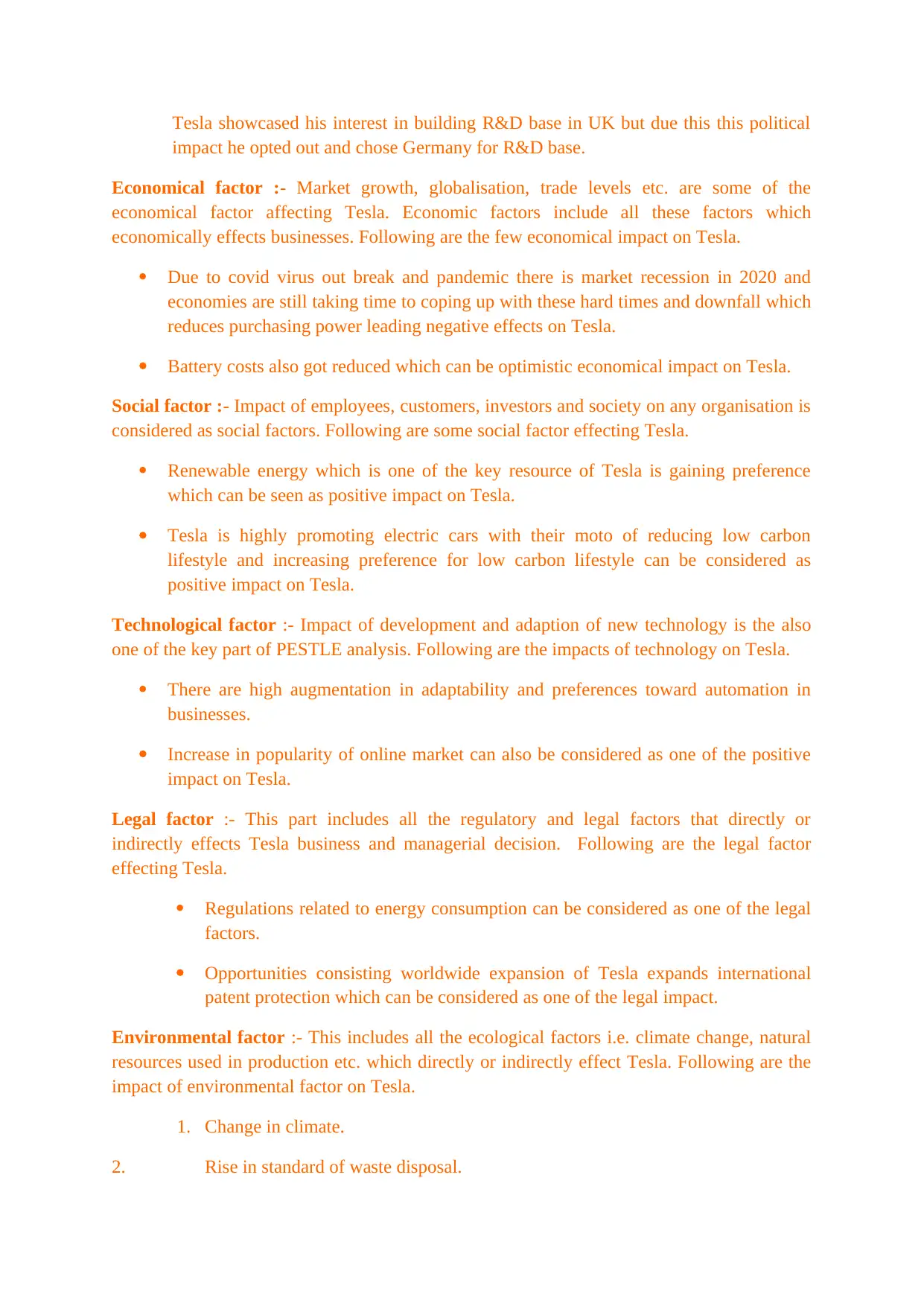
Tesla showcased his interest in building R&D base in UK but due this this political
impact he opted out and chose Germany for R&D base.
Economical factor :- Market growth, globalisation, trade levels etc. are some of the
economical factor affecting Tesla. Economic factors include all these factors which
economically effects businesses. Following are the few economical impact on Tesla.
Due to covid virus out break and pandemic there is market recession in 2020 and
economies are still taking time to coping up with these hard times and downfall which
reduces purchasing power leading negative effects on Tesla.
Battery costs also got reduced which can be optimistic economical impact on Tesla.
Social factor :- Impact of employees, customers, investors and society on any organisation is
considered as social factors. Following are some social factor effecting Tesla.
Renewable energy which is one of the key resource of Tesla is gaining preference
which can be seen as positive impact on Tesla.
Tesla is highly promoting electric cars with their moto of reducing low carbon
lifestyle and increasing preference for low carbon lifestyle can be considered as
positive impact on Tesla.
Technological factor :- Impact of development and adaption of new technology is the also
one of the key part of PESTLE analysis. Following are the impacts of technology on Tesla.
There are high augmentation in adaptability and preferences toward automation in
businesses.
Increase in popularity of online market can also be considered as one of the positive
impact on Tesla.
Legal factor :- This part includes all the regulatory and legal factors that directly or
indirectly effects Tesla business and managerial decision. Following are the legal factor
effecting Tesla.
Regulations related to energy consumption can be considered as one of the legal
factors.
Opportunities consisting worldwide expansion of Tesla expands international
patent protection which can be considered as one of the legal impact.
Environmental factor :- This includes all the ecological factors i.e. climate change, natural
resources used in production etc. which directly or indirectly effect Tesla. Following are the
impact of environmental factor on Tesla.
1. Change in climate.
2. Rise in standard of waste disposal.
impact he opted out and chose Germany for R&D base.
Economical factor :- Market growth, globalisation, trade levels etc. are some of the
economical factor affecting Tesla. Economic factors include all these factors which
economically effects businesses. Following are the few economical impact on Tesla.
Due to covid virus out break and pandemic there is market recession in 2020 and
economies are still taking time to coping up with these hard times and downfall which
reduces purchasing power leading negative effects on Tesla.
Battery costs also got reduced which can be optimistic economical impact on Tesla.
Social factor :- Impact of employees, customers, investors and society on any organisation is
considered as social factors. Following are some social factor effecting Tesla.
Renewable energy which is one of the key resource of Tesla is gaining preference
which can be seen as positive impact on Tesla.
Tesla is highly promoting electric cars with their moto of reducing low carbon
lifestyle and increasing preference for low carbon lifestyle can be considered as
positive impact on Tesla.
Technological factor :- Impact of development and adaption of new technology is the also
one of the key part of PESTLE analysis. Following are the impacts of technology on Tesla.
There are high augmentation in adaptability and preferences toward automation in
businesses.
Increase in popularity of online market can also be considered as one of the positive
impact on Tesla.
Legal factor :- This part includes all the regulatory and legal factors that directly or
indirectly effects Tesla business and managerial decision. Following are the legal factor
effecting Tesla.
Regulations related to energy consumption can be considered as one of the legal
factors.
Opportunities consisting worldwide expansion of Tesla expands international
patent protection which can be considered as one of the legal impact.
Environmental factor :- This includes all the ecological factors i.e. climate change, natural
resources used in production etc. which directly or indirectly effect Tesla. Following are the
impact of environmental factor on Tesla.
1. Change in climate.
2. Rise in standard of waste disposal.
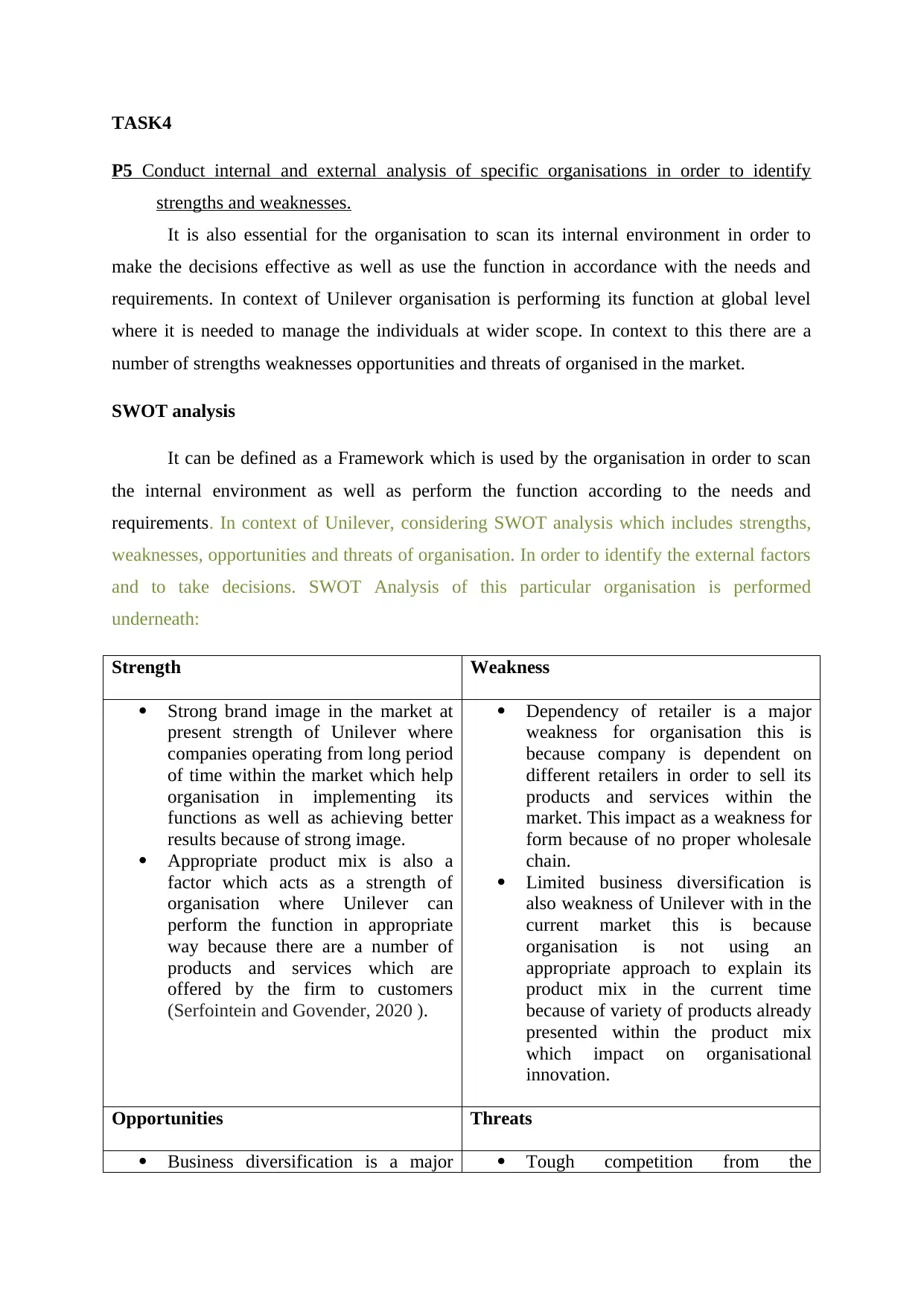
TASK4
P5 Conduct internal and external analysis of specific organisations in order to identify
strengths and weaknesses.
It is also essential for the organisation to scan its internal environment in order to
make the decisions effective as well as use the function in accordance with the needs and
requirements. In context of Unilever organisation is performing its function at global level
where it is needed to manage the individuals at wider scope. In context to this there are a
number of strengths weaknesses opportunities and threats of organised in the market.
SWOT analysis
It can be defined as a Framework which is used by the organisation in order to scan
the internal environment as well as perform the function according to the needs and
requirements. In context of Unilever, considering SWOT analysis which includes strengths,
weaknesses, opportunities and threats of organisation. In order to identify the external factors
and to take decisions. SWOT Analysis of this particular organisation is performed
underneath:
Strength Weakness
Strong brand image in the market at
present strength of Unilever where
companies operating from long period
of time within the market which help
organisation in implementing its
functions as well as achieving better
results because of strong image.
Appropriate product mix is also a
factor which acts as a strength of
organisation where Unilever can
perform the function in appropriate
way because there are a number of
products and services which are
offered by the firm to customers
(Serfointein and Govender, 2020 ).
Dependency of retailer is a major
weakness for organisation this is
because company is dependent on
different retailers in order to sell its
products and services within the
market. This impact as a weakness for
form because of no proper wholesale
chain.
Limited business diversification is
also weakness of Unilever with in the
current market this is because
organisation is not using an
appropriate approach to explain its
product mix in the current time
because of variety of products already
presented within the product mix
which impact on organisational
innovation.
Opportunities Threats
Business diversification is a major Tough competition from the
P5 Conduct internal and external analysis of specific organisations in order to identify
strengths and weaknesses.
It is also essential for the organisation to scan its internal environment in order to
make the decisions effective as well as use the function in accordance with the needs and
requirements. In context of Unilever organisation is performing its function at global level
where it is needed to manage the individuals at wider scope. In context to this there are a
number of strengths weaknesses opportunities and threats of organised in the market.
SWOT analysis
It can be defined as a Framework which is used by the organisation in order to scan
the internal environment as well as perform the function according to the needs and
requirements. In context of Unilever, considering SWOT analysis which includes strengths,
weaknesses, opportunities and threats of organisation. In order to identify the external factors
and to take decisions. SWOT Analysis of this particular organisation is performed
underneath:
Strength Weakness
Strong brand image in the market at
present strength of Unilever where
companies operating from long period
of time within the market which help
organisation in implementing its
functions as well as achieving better
results because of strong image.
Appropriate product mix is also a
factor which acts as a strength of
organisation where Unilever can
perform the function in appropriate
way because there are a number of
products and services which are
offered by the firm to customers
(Serfointein and Govender, 2020 ).
Dependency of retailer is a major
weakness for organisation this is
because company is dependent on
different retailers in order to sell its
products and services within the
market. This impact as a weakness for
form because of no proper wholesale
chain.
Limited business diversification is
also weakness of Unilever with in the
current market this is because
organisation is not using an
appropriate approach to explain its
product mix in the current time
because of variety of products already
presented within the product mix
which impact on organisational
innovation.
Opportunities Threats
Business diversification is a major Tough competition from the
⊘ This is a preview!⊘
Do you want full access?
Subscribe today to unlock all pages.

Trusted by 1+ million students worldwide
1 out of 17
Related Documents
Your All-in-One AI-Powered Toolkit for Academic Success.
+13062052269
info@desklib.com
Available 24*7 on WhatsApp / Email
![[object Object]](/_next/static/media/star-bottom.7253800d.svg)
Unlock your academic potential
Copyright © 2020–2025 A2Z Services. All Rights Reserved. Developed and managed by ZUCOL.





